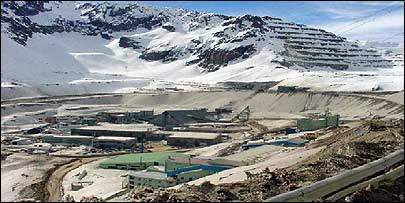Construction company Bechtel is initiating an RFID system designed by RFID Chile to track contracted workers as they construct a new mine at Los Bronces, in the Andes Mountains. Once fully deployed, in September of this year, the RFID system will enable the company to track thousands of workers as they clear the site and then build the copper mine, owned by Anglo American. That, says Jaime Ramirez, Bechtel’s information sciences and technology (IS&T) field manager for the Los Bronces project, will allow his company to track thousands of man-hours on the site in less time, with fewer errors.
Bechtel tracks workers not only at Los Bronces, about 65 kilometers (40 miles) northeast of Santiago, but also at the Las Tortolas ore-processing plant, 60 kilometers (37 miles) southwest of Los Bronces. At present, the sites have a total of 500 construction workers, supplied by a variety of independent contracting companies. Los Bronces is where most of the construction work is currently underway. Once winter passes in Chile, around September, Bechtel plans to fully deploy an RFID system that will track approximately 6,000 workers at Los Bronces on a daily basis for the entire three-year project.
To verify the number of hours the workers complete, Bechtel utilizes one timekeeper per approximately 200 employees. The timekeeper walks through both construction sites with a pen and paper. With winter underway in the mountains, at an elevation of about 10,000 feet, timekeepers currently walk through rough terrain—sometimes as much as 17 hours per day—stopping each worker and recording that person’s name and ID number on a piece of paper. Just writing down the names can be difficult, as timekeepers usually wear gloves since the temperature can dip to -10 degrees Celcius (14 degrees Fahrenheit) during the winter. A Bechtel employee then transposes all of those names to a single handwritten list. The entire process takes an entire day to accomplish.
While contractors punch in at time clocks upon arriving at and leaving the site, it is the records kept by timekeepers that list which crew, foremen and supervisors are located on the site, and where they are working. At the office at the end of the day, those handwritten names, locations and hours are input into the back-end ERP system by the office staff. The names are often difficult to decipher, mistakes can be made in the process of transposing them, and there is a delay between when the names are written on the job site and when they are input into the computer system.
The company had considered using a bar-code solution, since contracted workers already wear an ID badge on site that includes a bar code and is used to purchase food in the Anglo American cafeteria. But such a solution would require the timekeeper to maintain a clear a line of sight with the badge’s bar-coded number, and the construction worker would typically have to stop his work and hand the badge to the timekeeper for scanning. In addition, the bar codes often become dirty or faded.
With the system designed by RFID Chile, the company claims, the timekeeper’s job is made easier. As a matter of fact, Bechtel hopes its timekeepers will be able to sweep through the construction site twice daily to track man-hours, both in the morning and in the afternoon, using Motorola handheld RFID interrogators.
With the new system, each contracted worker will be issued a badge, manufactured by Smart Trac and containing a UHF EPC Gen 2 RFID chip. Bechtel will utilize a Zebra Technologies printer to print the employee’s picture, name and company name, as well as Rol Único Tributario (RUT) number (the Chilean tax identification number), which is printed both as numerals and in the form of a bar code. Once the badges are printed, says Max von Dessauer, RFID Chile’s technology director, Bechtel will utilize an Ensyc RFID Block—an RFID interrogator that plugs into a PC’s USB port—to encode the badge’s chip with the employee’s unique RUT number, linked in the database with the worker’s name and contracting company.
At the construction site, a timekeeper can approach within 5 or 6 feet of an employee and use the Motorola handheld reader to capture that person’s RUT number. A screen on the handheld will display the employee’s name and company, and the timekeeper can then follow prompts on the device to input the time and location where the individual is working, using a software system provided by RFID Chile.
After returning to the Bechtel office at the job site, says Javier Ignacio Torres, RFID Chile’s commercial manager, the timekeeper will utilize a USB port to connect the handheld to the company’s back-end system. There, the data will be displayed similarly to how it is displayed with the existing timekeeper system.
The company uses the timekeepers’ data not only to track man-hours for billing purposes but also to monitor efficiency and ensure that projected work time is accurate. In the future, the company also hopes to use the badges to allow workers access to transportation or accommodations at the construction site. The badges’ bar codes would not work well for access control, von Dessauer says, because they take too long to scan and are often rendered unreadable if they become dirty or damaged.
While the RFID-based timekeeping system is being deployed, RFID Chile is meeting with Bechtel’s timekeepers to develop the best process in the software to make capturing data efficient at the construction site. According to Ramirez, Bechtel is monitoring the project’s success and, based on that success, may decide to deploy RFID technology for tracking and locating small tools such as drills and other equipment used by construction personnel at sites throughout the world.


